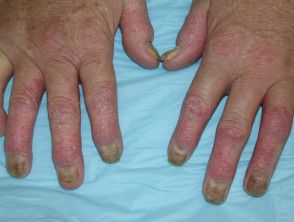- Case-Based Roundtable
- General Dermatology
- Eczema
- Chronic Hand Eczema
- Alopecia
- Aesthetics
- Vitiligo
- COVID-19
- Actinic Keratosis
- Precision Medicine and Biologics
- Rare Disease
- Wound Care
- Rosacea
- Psoriasis
- Psoriatic Arthritis
- Atopic Dermatitis
- Melasma
- NP and PA
- Skin Cancer
- Hidradenitis Suppurativa
- Drug Watch
- Pigmentary Disorders
- Acne
- Pediatric Dermatology
- Practice Management
- Prurigo Nodularis
- Buy-and-Bill
News
Article
Comparison of Psoriatic Arthritis Therapies Finds Bimekizumab More Effective Than Guselkumab
Author(s):
A matching-adjusted indirect comparison found that some patients with PsA are more likely to achieve long-term treatment outcomes with bimekizumab.
Certain patients with psoriatic arthritis are more likely to achieve stringent and long-term treatment outcomes when treated with bimekizumab compared with guselkumab, according to the results of a matching-adjusted indirect comparison (MAIC) published in Rheumatology and Therapy.1
Because there have been no direct head-to-head comparisons of the long-term use of bimekizumab and guselkumab in patients with psoriatic arthritis, a MAIC was used to compare the efficacy of the therapies.
Bimekizumab is a humanized dual IL17A and IL17F inhibitor, while guselkumab is an IL-23 inhibitor.
“Without head-to-head data, it has become standard to evaluate the relative effectiveness of several treatments by conducting a network meta-analysis (NMA) of placebo-controlled trials,” they explained. A recent NMA compared bimekizumab with other biologic or targeted synthetic disease-modifying antirheumatic drugs (b/tsDMARDs) over a short-term treatment period, but there are no analyses over the long term.
This MAIC assessed the relative efficacy of bimekizumab and guselkumab at 52 weeks. Patients included in the analysis had psoriatic arthritis and had either not been treated with bDMARDs or had an inadequate response or an intolerance to tumor necrosis factor inhibitors (TNFi-IR).
There are currently 5 TNFis approved for use in psoriatic arthritis in the US: etanercept, infliximab, adalimumab, golimumab, and certolizumab pegol. For patients who do not have an adequate response to a TNFi, increasing the dose usually is not beneficial,2 and even for those who do respond, they may have a loss of response over time.3
For the bDMARD-naive population, 431 patients on bimekizumab from BE OPTIMAL were matched to 493 patients (245 on guselkumab every 4 weeks and 248 on guselkumab every 8 weeks) from DISCOVER-2. Compared with both guselkumab regimens, bimekizumab had a greater likelihood of achieving 70% improvement in the American College of Rheumatology criteria (ACR70) and minimal disease activity, and it was more likely than guselkumab every 4 weeks to achieve ACR50. The treatments were comparable in achieving ACR20 at 52 weeks.
For the TNFi-IR group, 267 patients on bimekizumab from BE COMPLETE and BE VITAL were matched to 189 patients on guselkumab every 8 weeks from COSMOS. Bimekizumab’s outcomes were even better over guselkumab compared with the bDMARD-naive group. Bimekizumab had a greater likelihood of achieving ACR20, ACR50, ACR70, and minimal disease activity.
The authors noted that the analysis had limitations specific to the analysis but also intrinsic to a MAIC. For instance, patients in BE COMPLETE receiving placebo could switch to bimekizumab at week 16, introducing uncertainties in the data. Although observed patient variables at baseline were matched, there could be unobserved or unreported variables that were not possible to control for. Also, COSMOS only had 48 weeks of data compared with 52 weeks for the other trials; although this slight difference is not expected to substantially impact the results, given stable response rates after week 28, it is important to note. There were also variations in study designs across all of the studies included in the analysis.
However, the findings are still consistent with the recent NMA establishing that bimekizumab had a higher efficacy on most joint outcomes than guselkumab.
“The results of this study suggest that inhibition of IL-17A in addition to IL-17F may provide better long-term efficacy outcomes for skin and joint manifestations compared to IL-23 monoinhibition for the treatment of PsA; however, treatment decisions will still be driven by clinicians on a case-by-case basis,” the authors concluded.
References
- Warren RB, McInnes IB, Nash P, et al. Comparative effectiveness of bimekizumab and guselkumab in patients with psoriatic arthritis at 52 weeks assessed using a matching-adjusted indirect comparison. Rheumatol Ther. Published online March 15, 2024. doi:10.1007/s40744-024-00659-0
- Ruderman EM, Gordon KB. TNF inhibitor therapy for psoriatic arthritis. Healio. May 15, 2023. Accessed April 4, 2024. https://www.healio.com/clinical-guidance/psoriatic-arthritis/tnf-inhibitor-therapy-for-psoriatic-arthritis-treatment-options
- Mantravadi S, Ogdie A, Kraft WK. Tumor necrosis factor inhibitors in psoriatic arthritis. Expert Rev Clin Pharmacol. 2017;10(8):899-910. doi:10.1080/17512433.2017.1329009
[This article was originally published by our sister publication, American Journal of Managed Care.]







